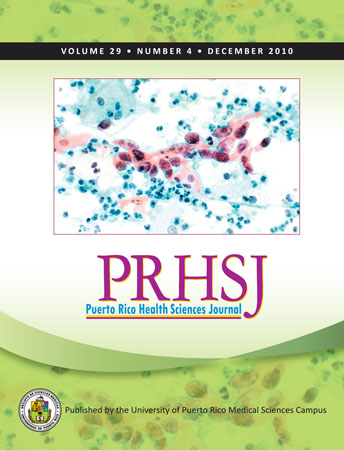Abstract
Objective: Hyperplastic polyps (HP) traditionally have been regarded as having no malignant potential. Some studies have suggested that HP in the distal colon may predict presence of adenomatous polyps in the proximal colon. Other studies have failed to show this relationship. The purpose of this study was to evaluate for the first time in our Hispanic veterans population if there was a relationship between the presence of sporadic HP and colorectal neoplasia (CRN) and to evaluate if proposed risk factors for CRN are also risk factors for sporadic HP. Methods: The study consisted of a retrospective review of all the medical records of patients who underwent a colonoscopy for the first time during the calendar year 2005 and had a pathologic diagnosis of HP, tubular adenoma (TA), tubulovillous adenoma (TVA), villous adenoma (VA) and/or colon adenocarcinoma at the VA Caribbean Healthcare System. Patient’s age, BMI, smoking and alcohol use history, presence of DM, cholesterol and triglyceride levels, use of aspirin and the size and location of the lesions were recorded. Records with incomplete data and patients with a prior colonoscopy were excluded. Results: 861 patient records were reviewed of which 405 met the inclusion criteria. Most patients (99%) of the patients were males, mean age 67.5 (range 36-87). The total number of colonic lesions was 1,065 (240 hyperplastic, 825 CRN). Histologic evaluation of lesions revealed: 121 patients who had HP, 331 with TA, 33 with TVA, 12 with VA, 13 with serrated adenomas and 61 patients had adenocarcinoma. Univariate analysis revealed that patients with HP appeared to have a lower likelihood of having TA (p < 0.001), adenocarcinoma (p=0.002), and CRN in general (P < 0.001) as compared to patients without HP. Multivariate analysis with logistic regression revealed that patients with HP had a significantly lower likelihood of having TA (adjusted OR = 0.21; 95% CI 0.12 - 0.37), and adenocarcinoma (adjusted OR = 0.33; 95% CI 0.15 – 0.73) compared to patients without HP. No correlation was found between DM, use of alcohol, smoking, or aspirin use and the presence of sporadic HP. Conclusion: The present study suggests that the presence of HP is not associated with CRN in our veteran population. None of the risk factors proposed for CRN appear to be also risk factors for developing HP. The results of this study support current colon cancer guidelines in which surveillance for HP is not recommended.
Authors who publish with this journal agree to the following terms:
a. Authors retain copyright and grant the journal right of first publication with the work simultaneously licensed under a Creative Commons Attribution License that allows others to share the work with an acknowledgement of the work's authorship and initial publication in this journal.
b. Authors are able to enter into separate, additional contractual arrangements for the non-exclusive distribution of the journal's published version of the work (e.g., post it to an institutional repository or publish it in a book), with an acknowledgement of its initial publication in this journal.
c. Authors are permitted and encouraged to post their work online (e.g., in institutional repositories or on their website) prior to and during the submission process, as it can lead to productive exchanges, as well as earlier and greater citation of published work (See The Effect of Open Access).
